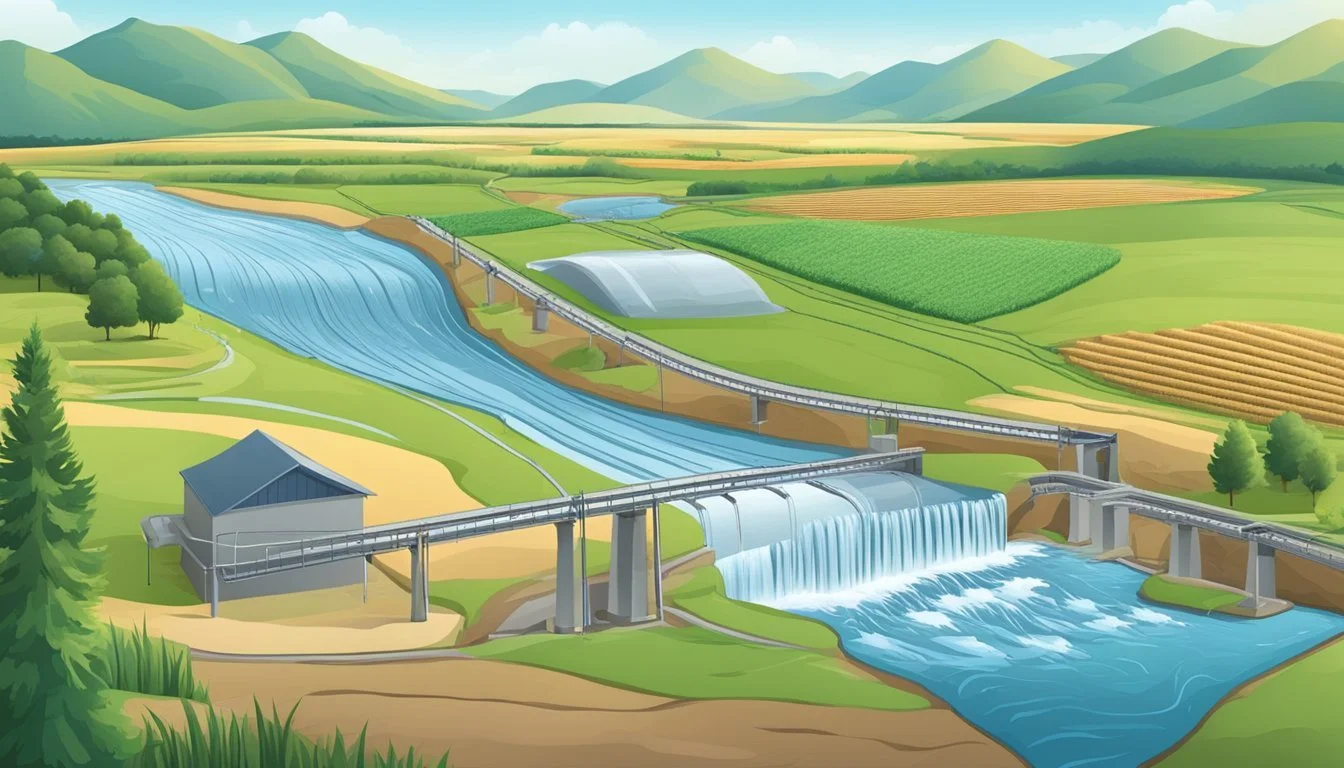Water Rights in Alabama
Navigating Legal and Environmental Challenges
Water rights in Alabama are a critical aspect of the state's legal and environmental framework, reflecting the significance of managing water resources for a diverse array of stakeholders. As an agricultural state with considerable industrial activity, Alabama's water laws have been shaped by historical precedents and evolving needs. The approach to water quality and rights in the state has undergone changes, especially as industrial demands increased following the Industrial Revolution. Traditionally, Alabama follows the riparian doctrine, which essentially grants rights to use water to those whose land abuts a water source.
The governance of Alabama’s water resources involves various legal principles that are essential for ensuring fair and sustainable use. The legal framework addresses both surface water and groundwater, establishing the rights and responsibilities of landowners and water users. The state has enacted regulations and policies to protect water quality for its citizens and the environment, acknowledging the public nature of water resources. The management of these resources requires balancing ecological protection with economic growth, a task undertaken by entities such as the Alabama Office of Water Resources.
For individuals and organizations planning to withdraw substantial quantities of water, specific requirements must be met to obtain legal authorization. This compliance ensures that water usage is in the best interest of all, adhering to the principle that natural resources should serve the public good. In essence, the water law in Alabama is a dynamic system that strives to accommodate the needs of its residents while preserving the integrity of its waterways and aquifers for future generations.
Historical Development of Water Rights
The historical development of water rights in Alabama is intricately linked to the natural landscape and evolving legal frameworks. These legal underpinnings have shaped the state's approach to managing its river systems, including the Apalachicola-Chattahoochee-Flint (ACF) River System and the Alabama-Coosa-Tallapoosa (ACT) River System.
Indigenous and Early Colonial Practices
In the era before European colonization, indigenous populations in what is now Alabama made use of the region's rivers and streams in a manner that was harmonious with the natural environment. Early colonial practices largely mirrored these sustainable use patterns, recognizing the inherent value of unobstructed water flow for transportation and basic sustenance.
Riparian Rights Doctrine
As Alabama evolved legally, it adhered to the Riparian Rights Doctrine. This principle, highlighted in the landmark case of Lewis. v. Stein, established that landowners adjacent to a watercourse had the right to make reasonable use of it without harming downstream owners. The doctrine formed the cornerstone of water use and rights for those along Alabama's waterways.
Prior Appropriation and Legal Evolution
Although Alabama encountered cases that hinted at the Prior Appropriation system common in the western United States, its courts rejected such applications. Instead, legal focus centered on developing a doctrine suited to Alabama's specific water needs, navigating disputes, and addressing the impacts of industrialization Alabama Water Law.
Interstate Water Compacts
Interstate water compacts have been crucial in managing shared water resources, particularly in disputes involving the ACF and ACT River Systems with Georgia and Florida. Such compacts aim to equitably distribute water rights and responsibilities across state lines, reflecting the complex legal and geographical nexus of the states' shared interests in water use and conservation efforts Interstate Water Disputes.
Foundations of Alabama Water Rights
The water rights in Alabama are shaped by the interplay between common law principles and state-specific doctrines that govern the use and management of water resources. These foundations are crucial for landowners and entities seeking to utilize water bodies within the state's jurisdictions.
Basic Legal Framework
In Alabama, the legal framework governing water rights is a combination of English common law and statutory regulations. A fundamental principle under this framework is the doctrine of reasonable use, which permits landowners to use water on or under their property as long as it does not unreasonably interfere with the rights of other landowners. Reasonable use encompasses both surface water and ground water, tailored by case law and legislative action over time.
Rivers and Streams
Per Alabama law, rivers and streams are generally considered waters of the state. Landowners adjacent to a river or stream have the right to make reasonable use of the water. However, this is conditioned upon the obligation not to harm other users downstream or upstream. The use of river and stream waters must also comply with state water quality standards.
Ground Water
Ground water rights in Alabama are determined by the reasonable use rule, which allows a landowner to extract ground water from the aquifer beneath their land. It is important to recognize that these rights are not absolute and must account for the rights of neighboring landowners, the potential for aquifer depletion, and environmental considerations.
Surface Water
The usage of Alabama's surface water, including lakes and non-navigable water bodies, adheres to the riparian doctrine. Riparian rights grant landowners whose property abuts a body of water the ability to make reasonable use of it. Usage must not unduly diminish the quantity or quality of the water such that it would affect other riparian landowners.
Regulatory Authorities and Administration
In Alabama, water rights and their administration are managed by several key authorities, each playing a critical role in ensuring the sustainability and legality of water use.
Office of Water Resources
The Office of Water Resources (OWR), a division of the Alabama Department of Economic and Community Affairs (ADECA), is responsible for coordinating the management of Alabama's water resources. OWR's duties include water policy development and planning, which entails monitoring water conditions and recommending policies to the Water Resources Commission.
Key Responsibilities:
Policy development and water management planning
Administering the state's water resources
Alabama Department of Economic and Community Affairs (ADECA)
ADECA plays a multifaceted role in the management of Alabama's water resources. It oversees the OWR and engages in programs to support economic growth and environmental stewardship. ADECA ensures that water laws align with sustainable economic development initiatives.
Broad Objectives:
Support sustainable economic and community development
Uphold environmental standards in line with water laws
Environmental and Water Resource Laws
Alabama's environmental and water resource laws are designed to balance the use and protection of water resources. The state's Environmental Management Commission and Board govern the implementation of these laws, overseeing activities such as water allocation and pollution control to protect Alabama's aquatic environments.
Legal Framework:
Governing water allocation and resource protection
Enforcing water quality standards
Water Rights Allocation and Use
In Alabama, the allocation and use of water resources are governed by principles that prioritize equitable distribution among landowners, municipalities, industrial entities, and the ecological needs of the environment. These regulations ensure that water use supports both economic activity and environmental conservation.
Agricultural Use
Agriculture is an integral part of Alabama's economy, and water rights for irrigation are essential for farmers. Agricultural use generally falls under the category of natural uses, prioritizing farming activities. Farmers may lease or sell water rights, reflecting the principle that water use should support agriculture as a beneficial use aligned with state interests.
Industrial and Municipal Use
Industrial and municipal uses of water in Alabama involve a more complex allocation process, including permitting and regulatory oversight. Industries and municipalities depend on reliable access to water for production and public services, respectively. These entities may also engage in water rights transactions to secure the necessary resources for their operations.
Private Landowners and Corporations
Private landowners and corporations hold specific water rights that enable them to utilize adjacent water bodies. In Alabama, water rights can be tied to the land and can therefore be appurtenant. Landowners can lease or sell these rights, often for purposes such as domestic use and recreational activities.
Ecological and Wildlife Considerations
Within Alabama's water rights framework, there is an increasing recognition of the importance of protecting ecosystems and wildlife. Water law stipulates that allocations must consider environmental sustainability, maintaining adequate flow levels to support the state's diverse ecological systems and species dependent upon them.
Water Management Challenges
Alabama's water management is confronted with significant challenges including sporadic drought conditions leading to water shortages, contamination affecting water quality, and disputes over interstate water allocation. These issues require immediate attention to ensure sustainable water management for the state's growing needs.
Drought and Water Shortage
In Alabama, drought episodes have been increasingly frequent, with six severe droughts recorded since the 1980s, including a historic drought from 2006 to 2008. These conditions pose serious threats to the state's water supply, particularly impacting the Alabama-Coosa-Tallapoosa (ACT) River System. The scarcity of water during such periods puts pressure on the state to effectively manage and allocate water resources, highlighting the value of proactive planning and conservation measures.
Contamination and Pollution
Water pollution is another pressing challenge facing Alabama, as contamination threatens the safety and usability of water bodies. Instances of industrial pollution and agricultural runoff lead to contaminated water sources, affecting not only the environment but also the health and quality of life of the residents. Alabama must enforce stringent regulations and implement purification processes to maintain the quality of its water resources.
Interstate Water Allocation Disputes
Disputes over the allocation of interstate water bodies are a continual point of contention. The Apalachicola-Chattahoochee-Flint (ACF) River System is central to a major dispute between Alabama, Florida, and Georgia. These disagreements can often become complex legal battles that require careful negotiation and adherence to equitable use doctrines to resolve the competitive demands of each state efficiently and fairly.
Rights and Responsibilities
In Alabama, water rights hinge on understanding the nuanced interactions between public needs and private rights, as well as the imperative to maintain environmental integrity. Regulations assert distinct roles for individuals, governments, and corporations with regard to the use and stewardship of water resources.
Landowner Water Rights and Limitations
Landowners in Alabama are entitled to reasonable use of surface water passing through their properties. However, they must also respect the right of downstream landowners not to have natural water flows significantly altered or polluted. Actions that cause harm to neighboring land or alter the natural flow of rivers, canals, or channels may be subject to legal challenge.
Municipal and County Responsibilities
Counties and municipalities in Alabama bear responsibility for ensuring access to clean water for their residents and for managing local water resources sustainably. This includes overseeing water treatment facilities to prevent pollution and maintaining infrastructure such as public canals and water channels. These entities must work within the framework of state water laws and environmental regulations.
Corporate and Industrial Accountability
Corporations, particularly those that utilize substantial amounts of water or may influence water quality, are mandated to comply with Alabama's environmental laws. This includes obtaining proper permits for discharges into waterways and taking necessary precautions to avoid pollution. Industries are under scrutiny to balance their economic activities with the duty to protect Alabama's rivers and other water bodies.
Environmental and Ecological Duties
Alabama law declares all its waters public, charging citizens, corporations, and governments with the duty to preserve the state's natural resources, including its waterways. It is imperative that all entities cooperate to shield the environment from harm and support ecological sustainability, with a focus on safeguarding water quality and the habitats dependent on Alabama's network of natural and man-made aquatic systems.
Techniques and Technologies
In Alabama, water rights prioritize the implementation of techniques and technologies aimed at both conserving water and enhancing its use for various purposes, including industry and agriculture. These efforts reflect the state's legal framework around water use and its commitment to the responsible management of this vital resource.
Efficient Water Use and Conservation
Efficient water use is paramount in Alabama, where legal doctrines govern the use and lease of water resources. Conservation techniques are linked closely with riparian rights, where landowners are encouraged to use water in a manner that is reasonable and not wasteful. Agriculture and industry sectors are compelled to adopt conservation practices to protect the interests of downstream users.
Improving Efficiency: The introduction of modern water-saving appliances and industrial processes serves to reduce water waste.
Conservation Incentives: Various lease agreements include clauses that incentivize the conservation of water, encouraging sustainable practices across users.
Advanced Irrigation and Pumping Solutions
Irrigation and pumping systems have a critical role in the management of Alabama's water resources, especially in the agricultural sector. These systems divert water with precision, thereby reducing wasteful overflow and inefficiency.
Irrigation: Technologies such as drip irrigation and computerized irrigation controls are common, which allow for minimal water use with maximum crop yield.
Pumping: Advancements in pumping technology enhance the ability to extract water efficiently from various sources, be it for a fee or part of a use agreement. Energy-efficient pumps and variable speed drives are now standard and reflect Alabama’s commitment to modern water management.
Legal Compliance and Dispute Resolution
In Alabama, water law compliance and dispute resolution are critical for equitable water distribution among individual rights holders and neighboring states. This includes litigation processes and negotiations related to water rights within the state and conflicts that arise with Georgia and Florida over interstate water allocation.
Navigating Water Rights Litigation
When an entity in Alabama, be it an individual, municipality, or corporation, chooses to enforce water rights or sell water rights, legal challenges can arise, particularly with respect to the use of streams and watercourses. The state's water law demands careful interpretation and a thorough legal strategy to navigate these challenges. Litigation concerning water rights often requires an understanding of both statutory laws and case precedents, such as those detailed in the document "Alabama Water Law". Expert legal advice is sought when disputes arise, ensuring compliance with state regulations and the fair allocation of water resources.
Resolving Interstate Conflicts
Alabama has been engaged in water-related disputes with neighboring states Georgia and Florida, particularly concerning the interstate allocation of water resources. Such disputes necessitate interstate negotiations and may require involvement from federal agencies. The Encyclopedia of Alabama elaborates on negotiations since 1989, which indicate the complexity of these disputes and the significant impact of increased development and urban expansion on water resources. Resolutions to these conflicts strive for a balance that protects the interests of all involved states while adhering to legal and environmental standards.
Contacts and Resources
In Alabama, individuals and organizations looking for guidance on water rights can rely on several governmental agencies and dedicated resources. These entities are equipped to manage concerns, provide information, and enforce environmental laws.
Governmental Agencies and Departments
Alabama Office of Water Resources: As part of ADECA, this office is instrumental in the management of the state's water resources. Key contacts include:
Contact Method
Phone
Toll-Free
Fax
Alabama Water Resources Commission: This commission is a part of ADECA and has 19 voting members. For more information on their role and responsibilities, visit the Commission's page.
Environmental and Water Law Resources
Alabama Environmental Law: Legal frameworks governing water rights and resources are available for public viewing. Publications by legal experts can be found in university repositories such as the Alabama Law Scholarly Commons.
Rules & Regulations: The Alabama Public Service Commission provides a detailed outline of water rules, which can be accessed via this water rules PDF document.
Each listed entity provides vital resources and contacts necessary for understanding and navigating the water rights in Alabama.
Frequently Asked Questions
In Alabama, water rights are a critical area of law, determining how property owners can use the water that flows through and around their land. This section provides a concise overview of common inquiries regarding the state's water rights framework.
How are water rights established for property owners in Alabama?
Water rights for property owners in Alabama are typically based on the riparian doctrine. Under this doctrine, landowners whose property abuts a natural body of water have the right to make reasonable use of it.
What are the specific riparian rights for landowners adjacent to a water body in Alabama?
Landowners adjacent to a water body in Alabama have the right to use water in a manner considered reasonable and consistent with the riparian rights doctrine. This means use should not significantly diminish the water available to other rightful users or harm the waterway.
Does the Alabama Office of Water Resources regulate water rights, and if so, how?
Yes, the Alabama Office of Water Resources is responsible for the regulation of water rights within the state. It manages Alabama’s water resources through planning, coordination, and technical studies, recommending policies that serve the state's best interests.
To what extent are Alabama's waterways considered public property?
Alabama's waterways are considered public property to the extent that they are navigable. Navigable waterways are held in trust by the state for public use, allowing activities like fishing, boating, and recreation.
In the context of Alabama law, what is the 'common enemy' doctrine regarding surface water?
The 'common enemy' doctrine in Alabama allows landowners to defend their property against surface water. Property owners may take measures to protect their land from water that could otherwise cause erosion or flooding. However, such actions should not unnecessarily harm neighboring properties.
What legal precedents govern the allocation of water rights among competing users in Alabama?
The allocation of water rights among competing users in Alabama is governed by case law and statutes that have evolved over time. These legal frameworks ensure equitable distribution among users and consider factors like historical use, the riparian doctrine, and reasonable use.










